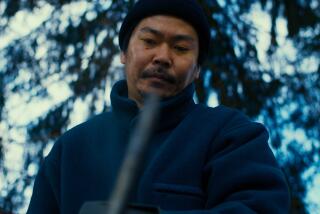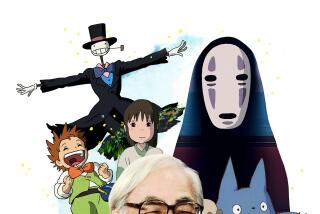A new creativity set loose by captivity
- Share via
For anyone not familiar with the work of the great Japanese artist Yasuo Kazuki, “Kazuki: This Is My Earth,” which closed Sunday night at Aratani/Japan America Theatre, will be a welcome initiation.
Written and directed by Yoshimasa Shinagawa, the biographical play, a production of Tokyo Gingado, is winding up a limited U.S. tour before returning to Japan. A major cultural outreach that bodes well for artistic exchanges between the countries, “Kazuki” is seldom lost in translation.
Kazuki, who died 30 years ago at age 62, is perhaps most celebrated for his famed “Siberian Series,” the savagely creative outpouring that he commenced shortly after World War II.
In Manchuria when the war ended, Kazuki, then in his 30s, was transported to a Siberian labor camp, where the prisoners subsisted on infrequent cups of sorghum soup and the temperature hovered at 40 below zero. It was a harrowing yet formative time for Kazuki the artist, whose previous work had centered on colorful nature studies. Upon his return to Japan, Kazuki felt a compulsion to paint and repaint his bitter experiences in the Siberian gulag. When other Japanese artists of his generation were, by and large, ignoring the bitter legacy of the war, Kazuki confronted it head on, with enduring results.
That artistic transformation is at the heart of Shinagawa’s delicate drama, which vaults back and forth in time to various intervals in Kazuki’s life, from his days as an art student, to his serene and happy domestic life, to, of course, his harrowing tenure in Siberia. Presented in Japanese with English subtitles, the play consists of a prologue, six scenes and an epilogue.
Interestingly, only one of the scenes is set in Siberia -- but it is epic, a heart-rending portrait of redemptive male fellowship in the face of death and degradation. Much as Kazuki did in his own work, Shinagawa effectively contrasts the elemental -- the cheering sound of water running in a kitchen, the radiance of a sunset -- with the grim, gray bleakness of war.
The wonderfully expressive Hiroyuki Nishimoto plays Kazuki at the peak of his fame, while wiry and intense Jiro Tsuda plays the younger Kazuki, whose life is so devastatingly disrupted. Sachiko Yoda shows great humor and subtlety as Kazuki’s wife, while Chiho Terada is heartbreakingly winsome as Kazuki’s brain-damaged daughter, able to speak to her father only in fantasy.
Superlative design elements include Chika Kato’s theatrical design, Yoshiaki Seki’s lighting, Takumi Imanishi’s sound and Toru Ueda’s haunting original music. Arresting tableaux are accomplished through the liberal use of scrims.
The most visually striking element, however, is Kazuki’s art, projected on a large screen between scenes. In this production, Kazuki’s genius speaks for itself -- eloquently.
More to Read
The biggest entertainment stories
Get our big stories about Hollywood, film, television, music, arts, culture and more right in your inbox as soon as they publish.
You may occasionally receive promotional content from the Los Angeles Times.










